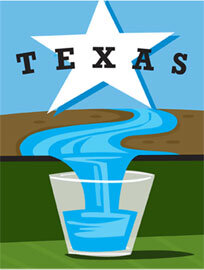
Business/Industry
You Can Prevent Nonpoint Source Pollution
When rain or stormwater flows across rooftops, lawns, streets, parking lots, construction sites, and open lots it collects all kinds of pollution from “nonpoint sources” and washes them into our rivers and streams. Typical pollutants from stormwater pollution include sediment (dirt), oil and grease, fecal coliform, pesticides and fertilizer, lawn clippings, debris, and heavy metals.
Contrary to what you might think, stormwater runoff does NOT flow into the sewer and to the wastewater treatment plant for treatment (clean up). Polluted stormwater flows directly into our freshwater rivers, streams, and lakes. It also can impact groundwater sources. Cleaning up contaminated water can be costly or not possible. Preventing pollution by applying “Best Management Practices” (or BMPs) is easier and more economical.
General BMPs
There are various BMPs in pollution prevention for businesses of all types. Learn more about these actions to protect source waters.
-
Develop and implement pollution prevention plans, targeting elimination and/or reduction of toxic substances, source reduction, reuse and recycling, and energy recovery for your business. Pollution prevention example plans are available and assistance regarding the planning basics. Further information can be found at these sites:
-
Hazardous materials that are not stored properly have much greater chances of entering the waterways. The Texas Administrative Code regulates industrial waste and municipal hazardous waste. Refer to the Secretary of State's website for details of the regulations.
Elements of proper hazardous materials storage can include:
Maintaining Sufficient Aisle Space
Storing Away from High Traffic Areas
Stacking in Accordance with Manufacturers’ Directions
Storing on Pallets
Delegating Responsibility to Trained Hazardous Substance Management Personnel
Covering or Enclosing Hazardous Materials Areas
Considering the Usable Life of Container
For further information refer to Menu of BMPs: Hazardous Materials Storage. (U.S. EPA, July 2001).
-
Proper materials management involves the responsible selection, use, storage, and disposal of a product. These actions will help prevent the materials from entering waterways.
Key components of Materials Management include the following:
Minimize Materials Used
Minimize Waste Generated
Routine Housekeeping
Proper Collection and Disposal of Wastes
Maintenance
Regular Inspection
Employee Training
Materials Inventory: identify all substances; label all containers (name, unit number, expiration date, handling instructions, and health and environmental hazards); note hazardous chemicals
For further information refer to Menu of BMPs: Materials Management. (U.S. EPA, July 2001)
-
To protect storm drains from spills and leaks, a spill response and prevention plan should be developed. These plans include spill prevention measures, response procedures, cleanup procedures, reporting and training. Product substitution and use of recycled, reclaimed, and reused materials may reduce the toxic materials requiring a spill response and prevention plan.
Key components of the Spill Response and Prevention Plan include the following:
Description of Facility, Address, Activities and Materials
Identification of Spill Response Personnel
Identification of Potential Spill Areas or Operations
Identification of Areas Requiring Berms
Facility Map (Including Areas, Activities, Materials, Structural BMPs etc.)
Material Handling Procedures
Spill Response Procedures: assessment of site and potential impacts; containment; notification; clean up; disposal; record keeping
Spill Prevention Measures in the plan may include the following:
Install Leak Detection Devices, Overflow Controls, and Diversion Berms
Disconnect Drains to Storm Sewer
Preventative Maintenance
Minimize Spills
Product Substitution
Recycle, Reclaim, or Reuse Materials
For further information refer to Menu of BMPs: Spill Response and Prevention. (U.S. EPA, July 2001).
-
Trash management involves source control and structural control to reduce the amount of trash present in stormwater and entering source waters.
Types:
Source Control: waste reduction; public education; infrastructure; clean-up programs;
Structural Control: filtration; centrifugal separation
For further information refer to Menu of BMPs: Trash Management. (U.S. EPA, July 2001).
Industry-Specific BMPs
GUN RANGES
PSOCs: lead
Industry-Specific Resources:
AUTOS
Repair, Parts, Sales, Salvage, Towing
PSOCs: hazardous wastes, hydrocarbons, trace metals
Industry-Specific Resources:
GOLF COURSE
PSOCs: Fertilizers, pesticides
Industry-Specific Resources:
DRY CLEANERS
PSOCs: Perchloroethylene, other solvents and chemicals, separator water, used carbon and cartridges from absorbers, residues and sludge from stills, filter powder, filters, rags, and extra chemicals and drums
Industry-Specific Resources:
PETROLEUM STORAGE TANKS
PSOCs: Petroleum products
Industry-Specific Resources:
Technical Assistance for Implementing BMPs
Small businesses are eligible to receive free on-site technical help with pollution prevention from the Texas Commission on Environmental Quality’s Small Business and Local Government Assistance (SBLGA) program.
The program provides confidential technical assistance without the threat of enforcement. Help is available from regional offices located throughout the state; click here to find the nearest Compliance Assistance Specialist or call toll-free at 1-800-447-2827.
The Environmental Protection Agency has developed a special resource guide entitled Environmental Assistance Services for Small Business.
The following are shortcuts to compliance tools for specific operations:














